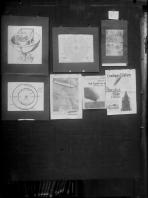Children of Mars, A Modern Diagram after Kepler
Warburg has chosen the planet Mars as an exemplary case for demonstrating his theory. His point of departure is an illumination depicting Mars as the ruler of April with his children. The illumination stems from a manuscript, an astrological Hausbuch or, more precisely, a latro-mathematical calendar book – now kept in the University Library of Tübingen. It was produced in the third quarter of the 15th century by a Master Joseph who worked in the Carthusian monastery of Güterstein near Bad Urach. Mars is represented as a medieval knight with halberd and spear. He is prominently depicted in a circle in between the zodiacal signs of Libra and Virgo. Scorpio and Taurus, his astrological houses, are just visible behind the circle. The lower half of the sheet is devoted to the earthly sphere where Mars’s ‘children’ are following their destiny. Under the martial influence of their ruler they have become warriors, seen here in the course of setting a house on fire, killing, and other atrocities. Also a slaughterer is depicted. Warburg was interested in the persistence of the belief in the individual’s dependency on the planet under whose influence it was born. He wanted to demonstrate that even the most enlightened minds struggled to overcome such influence. Kepler’s dedication of his Astronomia nova to emperor Rudolph II offered just such an example as Kepler speaks about his final victory over clever god Mars who for a long time withstood his attempts to defeat him before he, Kepler, finally succeeded with the help of his own warrior god Mars. Mars had initially been – in the double-meaning of the German word – ‘unberechenbar’ (volatile and incomputable). Once Mars was defeated, however, Kepler had to keep fighting against disbelievers in the ellipse as a geometrical form.
